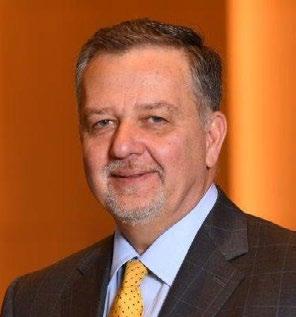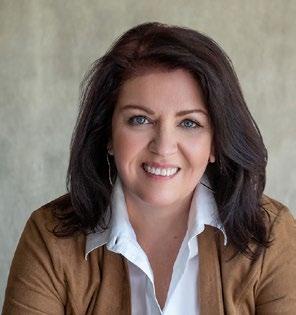
9 minute read
A MATTER OF CHEMISTRY
Written By Bruce Shutan
Biosimilars, chemical copies of biologic drugs, hold promise for unlocking significant Rx cost savings
TThere’s a promising development in the Rx space largely flying under the radar across the self-insurance community. While a combination of bureaucratic and market barriers currently stand in their way, experts are hopeful that educating key stakeholders will unlock a potentially game-changing solution. Significant cost savings can be realized, alongside better clinical outcomes, through the use of biosimilars, according to research and recommendations released earlier this year by the nonprofit National Alliance of Healthcare Purchaser Coalitions. Biosimilars are chemical copies of biologic drugs that have more complex proteins made from living cells, explains Margaret Rehayem, the group’s vice president. Their traction in the U.S. is manly dependent on policymakers to address the lack of transparency and misaligned incentives. In stark contrast, the European Union is several years ahead for biosimilars where the results are lower prices and higher uptake.
Only slightly more than 30 biosimilars have been approved in the U.S. over the past decade with about 160 more in the R&D pipeline, Rehayem says. A pandemicrelated backlog at the Food and Drug Administration delayed approvals of anything other than COVID-related vaccines and treatments, but the floodgates are expected to open by next year and beyond.
The European market where several hundred biologics have been approved and drug prices have come down “didn’t have as many guardrails in place when biosimilars came out,” she notes. “There’s not as much of a bureaucratic pathway to get biosimilars into use because of a health-care-for-all approach.” Also, she says access to biosimilars can be limited when a pharmacy benefit manager’s (PBM’s) formulary favors brand-name biologic drugs for which rebates are available.
Not surprisingly, it has been difficult to assess the value of biosimilars in the U.S. given the snail’s pace of product approval and biologics dominance. “We’re

Eric Barker
approving record numbers of medications most years, many of which are specialty in nature,”
says Eric Barker, RPh, chief growth officer of True Rx Health Strategies, “so the biosimilar market is lagging far behind expectations.”
OVERCOMING SIGNIFICANT BARRIERS
While educating health plan sponsors and members about the merits of biosimilars is top of mind, that effort extends to winning over the hearts and minds of doctors. “The biggest challenge is probably adoption in the physician community,” suggests Andy Crighton, M.D., former chief medical officer of Prudential Financial and a member of the National Alliance Medical Director Advisory Council.
It’s important that they’re comfortable prescribing biosimilars since patients rely heavily on their provider to recommend scripts and respect their expertise. Biosimilars initially were perceived as inferior to biologics, which he attributes to some bias and misinformation in the early communication of these drugs. But that view hasn’t panned out in studies, he hastens to add.
Crighton says biosimilars are available to treat the same inflammatory conditions that biologics target, including rheumatoid or psoriatic arthritis, as well as some inflammatory bowel conditions, but in a more cost-effective way. The problem, he notes, is that there’s an inherent fear of trying something new on patients that have painful inflammatory conditions with the potential for serious side effects.
Another point worth considering is that it’s hard to bring a biosimilar to market relative to, say, generic medication. The manufacturers of original medications have argued that biosimilars are not strictly an interchangeable product that meets additional requirements outlined by the Biologics Price Competition and Innovation Act, Barker reports.
So a barrier to entry is the point of sale at pharmacy counters where serious time constraints make it difficult to exchange specialty drugs for biosimilars, he says. For example, a pharmacist is free to fill a prescription for Lipitor with the lesscostly generic equivalent without needing permission from the patient’s doctor to make that change. “Yet many laws around biosimilars require the pharmacist to make a phone call to enable that exchange, allow that substitution to happen,” Barker
explains.
While he would love to be able to say that biosimilars have been a great solution to helping control specialty medication costs, it’s difficult to make that case because there simply aren’t enough of them in the market. “But that being said,” Barker notes, “as a pharmacist, I’m very comfortable for any of our patients to be prescribed a
biosimilar in place of the specialty medication. I think they’re safe and effective.”
ENORMOUS SAVINGS POTENTIAL
The potential for cost savings, though not fully realized at the present, may be enormous. Bill Miller, CEO of Drexi, an AMPS company, expects biosimilars to cut 75% to 80% off the cost of biologics. “Half of the spend is happening in these specialty drugs, which really only accounts for 1% to 2% of the employees,” he says. That means 10 to 20 members in Andy Crighton a 1,000-employee group will drive 50% of pharmacy cost for the entire plan, which could be up to 25% and 30% of the overall medical spend for the employer.

In order to realize this potential, there needs to be a change in overall approach. Self-insured health plans tend to focus on population health that supports their workforce around wellbeing or condition management. But Rehayem of the National Alliance says pharmaceutical manufacturers set themselves up to focus on more of a precision medicine model, which is where the market is moving, particularly for costly specialty pharmacy solutions.
“Employers need to catch up around their benefit design and being able to deliver the right drug at the right time to the right
patient,” she opines. That includes being more knowledgeable about care available pathways and what’s on formulary or should be added to the list. It also involves leaning in more to medical and pharmacy, not just the pharmacy side of their drug spend.
The National Alliance has suggested to its members that they implement health plan and formulary design changes, along with tweaks to drug pricing and rebates, and study the impact of site-ofcare on cost of delivery.
Rehayem says the group is “looking at not only educating employers, but a deeper dive with a few of the coalitions and really taking a look at their own data. Key points include uncovering the biggest challenges associated with getting biosimilars on formulary, as well as how to move forward with formulary and benefit designs and Rx administration.
There’s a need to not just provide resources and tools, but actually take employers through a process, which the National Alliance calls a learning collaborative that allows members to share data and experiences. The study involves three coalitions that are bringing in three employers apiece. The goal is to educate employers and empower them to push back with their own Rx vendor partners and consider a more thoughtful approach.

ALL EYES ON HUMIRA
One area where the gradual emergence of biosimilars will be closely watched involves Humira, a blockbuster biologic drug with more than $21 billion in U.S. sales. It was the best-selling of the top 200 pharmaceuticals based on retail sales that the University of Arizona studied other than Covid-19 vaccines, Miller notes. He says Humira’s
staggering sales are “roughly above the entire economy of Iceland and somewhere around the middle of the pack of GDPs of countries.”
With about eight biosimilars for Humira called adalimumab eventually expected to hit the market, along with a significant number of other biosimilars, Miller agrees with other industry experts that the chief challenge will be educating health plan members and clinicians alike about this drug category.
There are three areas where biologics, also known as “reference” drugs when they’re first created to treat a particular condition, have made inroads and created significant expense for self-insured plans, according to Miller. They include insulins, autoimmune and cancer drugs. As such, this is where there will be growing opportunities for biosimilars.
“The very first biosimilars that are being approved are in the insulin side,” he reports. “The FDA is trying to make things a little bit simpler and not requiring in some instances the switching studies so that a pharmacist can make the change with a biosimilar.”
The biggest change that happened at the beginning of 2020 was the two main manufacturers for fast-acting insulin in the U.S., Eli Lilly and Novo Nordisk, both have products. Humalog is from Eli Lilly and Novolog is from Novo Nordisk. “Each company has exactly the same situation,” Miller notes. “The analogs are exactly the same for Novo Nordisk. Eli Lilly came out with a biosimilar for their Humalog called Insulin Lispro.” It’s priced at about $284 for one vial, and with the average person using about two vials per month, he says the roughly $568 price-tag is a huge amount of money with much of it in rebates and spread pricing arrangements between Eli Lilly and the member.
Since there was some pressure to bring down the cost of insulin, a generic version came out. “Now, it’s actually a biosimilar, but in this case because it’s exactly the same, it’s a bioequivalent,” he explains. “You can get this in places for $30. If we could get the education out to the members and employers to tell them that if they were researching this particular information, they could save 90% on their insulin costs if they directed their members into this Insulin Lispro, which is made on the same manufacturing line as Humalog.”
The tricky part is that prior authorization is required to obtain the generic bioequivalent insulin, which Miller describes as a huge barrier to saving money for both the members and the plan. Reiterating the importance of education, he suggests a transparent or fiduciary PBM will help the plan put them on formulary, whereas it would be more difficult using one of the big-three PBMs because of their rebate strategy.
Bill Miller

Miller observes. “If an employer understands what’s going on, they can take steps to overcome those headwinds.”
In the end, embracing biosimilars can help move the needle on containing the cost of prescription drugs, what have long been the fastest-growing segment of health care costs. “Biosimilars and biologics are treating very complicated diseases,” Crighton points out, “so having more options available will not only benefit patients and result in better adherence to drug regimens, but also keep self-insured health plan costs under control.”
Bruce Shutan is a Portland, Oregon-based freelance writer who has closely covered the employee benefits industry for more than 30 years.




